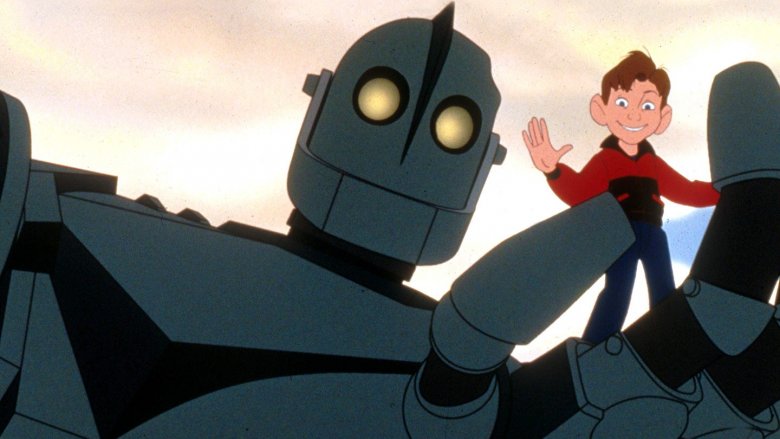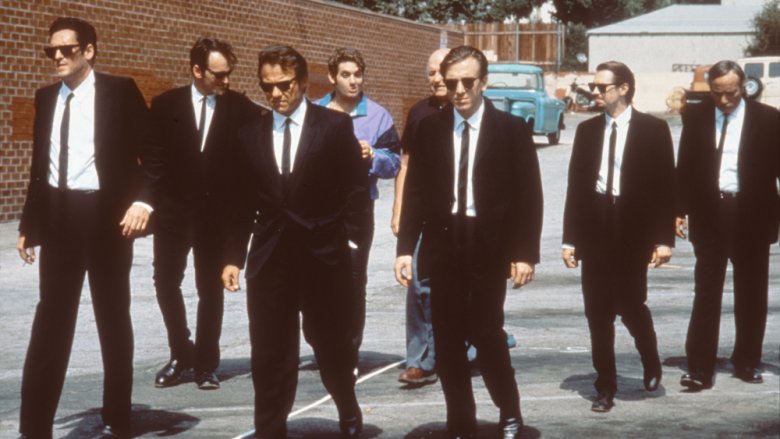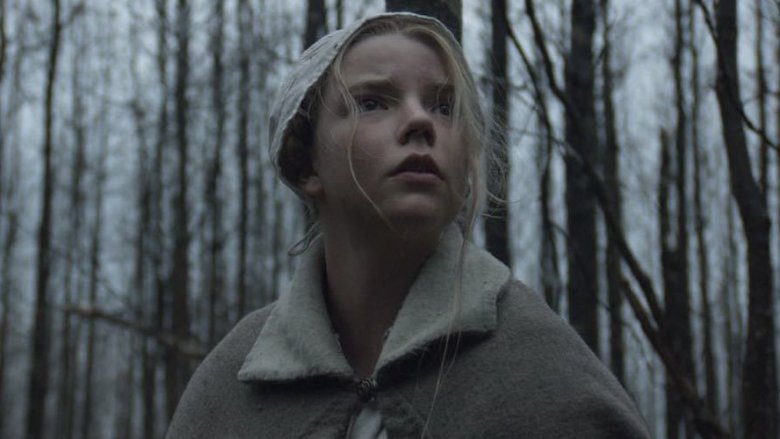The Best Directorial Debuts Of All Time
In 1941, RKO Radio Pictures released Citizen Kane, a film that tells the story of a fictional newspaper tycoon who rises to power and loses his soul. It's a powerful character study featuring innovative camera techniques, staggering visuals, and fantastic performances from a prestigious cast. And close to a century later, Kane is widely hailed as the greatest movie ever made.
That's some high praise right there, and it's especially impressive because Citizen Kane marked the directorial debut of Orson Welles (who also starred, co-wrote, and produced). Welles was only 25 when he signed onto the project — while he was a master of both radio and theater, he'd never made a film before. But that didn't stop the wunderkind from crafting one of the most highly acclaimed movies in history and setting the bar for directorial debuts.
Now, it's pretty hard to top Citizen Kane, but plenty of first-time filmmakers have given it their best shot. After starting with short films, TV shows, music videos, or screenwriting, these up-and-comers burst onto the scene with feature films that left us all amazed. Maybe they debuted with a sci-fi film or a horror hit, or perhaps they introduced themselves with a comedy or a thriller. Whatever the genre, these filmmakers put everything they had into their first films, giving us the best directorial debuts of all time.
Jennifer Kent scared us to death with The Babadook
If it's in a word or if it's in a look, you can't get rid of The Babadook — this Australian horror movie is here to stay. Released in 2014, The Babadook terrified audiences (especially parents) around the world, and the woman who brought this freaky film to life was first-time director Jennifer Kent. Originally, Kent started out as an actress, but her career trajectory changed after emailing Lars von Trier and asking if she could work on his minimalistic and incredibly depressing Dogville. After getting first-hand experience working as part of von Trier's directing attachment, Kent went on to direct an episode of an Australian mystery show called Two Twisted before making a short film called Monster. That eventually evolved into The Babadook, with its creepy pop-up book and top hat-wearing ghoul.
Grappling with the devastating power of grief and depression, the movie was immediately hailed as a horror classic. Plus it gave us a landmark monster, one who's just as iconic as Freddy Krueger or Michael Myers (and who's since become an LGBT icon). And when Stephen King and William Friedkin (The Exorcist) say your film is one of the scariest movies ever made, that's a pretty good way to start your career.
David Lynch got all surreal with Eraserhead
Whether he's on TV or up on the big screen, David Lynch is the king of freaky dream imagery. Reading through this man's filmography is like remembering a whole bunch of beautiful nightmares. He's directed classics like Mulholland Drive, Blue Velvet, and Wild at Heart, and then there's the nostalgic, unnerving world of Twin Peaks. But before Lost Highway or Inland Empire, Lynch was getting all surreal with Eraserhead.
This black-and-white fantasy is a disturbing look at the horrors of parenthood, but turning Jack Nance into a hairstyle icon wasn't always Lynch's number one goal. He actually got started as a painter, studying at the Pennsylvania Academy of Fine Arts. But one day, Lynch imagined his paintings moving around, and that inspired him to make some unsettling short films like 6 Men Getting Sick 6 Times and The Alphabet. From there, Lynch directed his first feature, an experimental story set in an industrial hellscape, one populated with bleeding chickens and cinema's scariest baby. And over 40 years later, the movie still packs a sinister, surreal wallop. There's no shaking the dread of Eraserhead.
Ryan Coogler broke our hearts with Fruitvale Station
In 2018, Ryan Coogler made Hollywood history with Black Panther. The Marvel film earned a whopping $1.3 billion, making it the highest-grossing movie ever by a black director. Even more impressive, it was Coogler's third film. That's right — third film. In an incredibly short amount of time, Coogler has become one of the most important filmmakers working today, but this guy had buzz before introducing us all to Wakanda. One moment, Coogler was a USC film student making thoughtful short films about a young man getting a haircut or a prostitute trying to start a new life. The next, he was directing Fruitvale Station, a heartbreaking biopic about Oscar Grant, a young black man shot to death by a white cop.
It's a tragic but beautiful movie, the kind that will wring every single tear from the human body, and it also marked Coogler's first collaboration with his leading man muse, Michael B. Jordan. The two would join forces again for Creed and the aforementioned Black Panther, and while those films are the very best of the blockbuster genre, it's Fruitvale Station that leaves audiences crying, seething, and thinking as the credits roll.
Jordan Peele freaked us out with Get Out
Before 2017 rolled around, Jordan Peele was best known as a brilliant comedian, thanks to his work with Keegan-Michael Key on shows like Mad TV, Fargo, and obviously, Key & Peele. At the time, nobody could've guessed Peele would become the modern-day Rod Serling, but really, the clues were there all along in his comedy sketches that tackled topics like race relations and the horror genre. Still, when Get Out finally arrived in theaters, critics and audiences were both blown away and quaking in their boots.
The film was a perfect blend of chuckles and chills, and it gave us one of the most iconic images in horror movie history: the Sunken Place. The movie also nabbed multiple Oscar nods, including ones for Best Picture and Best Director. And while Peele lost the directing award to Guillermo del Toro, he did walk away with the Oscar for Best Screenplay. Of course, we should probably emphasize that Peele got a Best Director nomination for his very first film. On top of that, the movie earned $250 million at the box office, became a milestone for both horror and black cinema, and forever changed the way we think about teacups. Not too shabby for a directorial debut.
Ben Affleck reinvented himself with Gone Baby Gone
Ben Affleck was at a weird point in his career before Gone Baby Gone. The actor had his big break ten years before with Good Will Hunting, winning an Oscar alongside Matt Damon for Best Screenplay. He then started racking up big roles in popular films like Shakespeare in Love and Armageddon. But in the early 2000s, Affleck starred in a series of the worst films ever made, including Gigli, Daredevil, and Surviving Christmas. The actor was in a downward spiral, and that's when he got a brilliant idea — what if he sat on the other side of the camera?
Granted, Affleck had some directorial experience with a '93 short film entitled, ahem, I Killed My Lesbian Wife, Hung Her on a Meat Hook, and Now I Have a Three-Picture Deal at Disney, but Gone Baby Gone was a completely different challenge. This was a feature length film based on a Dennis LeHane novel, coming just four years after Clint Eastwood's prestige adaptation of LeHane's Mystic River. But after struggling in the Hollywood system for so long, Affleck finally re-established himself with this mystery-thriller. It's a film that lives and breathes the gritty streets of Boston and features terrific performances from Amy Ryan and Ben's little bro, Casey Affleck. It's dark, devastating, and proof that Affleck is totally at home in the director's chair.
Ana Lily Amirpour made a genre-bending gem with A Girl Walks Home Alone at Night
While The Bad Batch stirred up controversy with its acid tripping-pace and flesh-eating Aquaman (for the record, we think it's criminally underrated), there's no denying Ana Lily Amirpour is a filmmaker with a unique and unusual vision. The American-English-Iranian director has been making movies since she was 12, but after graduating from UCLA, she earned comparisons to Quentin Tarantino and Jim Jarmusch with her feature-length debut, A Girl Walks Home Alone at Night.
A story about longing, loneliness, and undead skateboarders, this ain't your run-of-the-mill vampire movie. It's black-and-white, the whole thing is in Farsi, and it feels like Nosferatu mashed with A Fistful of Dollars. Amirpour self-funded the movie with an Indiegogo campaign, and as a result, she created a sexy, stylish movie set in the barren world of Bad City, a place where a chador-wearing vampire stalks awful men, where everything is accompanied by indie rock, and everybody is borrowing their vibe from the legendary James Dean. While vampire movies certainly seemed played out in 2014, Amirpour reinvigorated the genre with her Spaghetti Western sensibilities, making sure everyone took notice of her bloody good debut.
Ari Aster made us terrified of our families with Hereditary
What if Wes Anderson and Stanley Kubrick decided to join forces and direct one of the scariest movies ever made? Well, the result would look a whole lot like Hereditary, a truly upsetting horror film from the mind of Ari Aster. The first-time filmmaker was an alumni from AFI's directing program, and before delving into the world of Paemon and peanut allergies, Aster made a series of disturbing short films, a couple of which focus on incredibly dysfunctional families (e.g. Munchausen and The Strange Thing About the Johnsons). From there, Aster painstakingly assembled a traumatizing film about a family falling apart at the seams. Hereditary explores the ideas of mental illness, grief, and fate vs. free will, plus it features the finest and fiercest performance of Toni Collette's career. And, oh yeah, this messed-up movie has one of the most shocking deaths in horror — nay, cinematic — history. Widely hailed as the most terrifying film since The Exorcist, Hereditary put Aster on the map, forced us to drive a little more carefully, and made us all check the ceiling once or twice before bed.
Brad Bird gave us an animated classic with The Iron Giant
Before Remy the rat learned to cook, before the Incredibles learned to work together, and before Ethan Hunt scaled the Burj Khalifa, there was a little boy named Hogarth, and he was best friends with a robot from outer space. Released by Warner Bros., The Iron Giant is a beautifully animated film from director Brad Bird, a CalArts student who got his start working with Disney. While animating The Fox and the Hound (along with Tim Burton, John Lasseter, and Don Bluth), Bird was fired from the House of Mouse for "rocking the boat," and after working on TV shows like Rugrats, The Simpsons, and Steven Spielberg's Amazing Stories, he made his directorial debut with an all-time classic.
Set in Cold War America, The Iron Giant deals with some pretty heavy themes for a kids' film, like the nature of the soul, overcoming your past and choosing your own path, and the destructiveness of guns and patriotic paranoia. While the movie earned rave reviews, it was a major box office bomb. But 20 years later, The Iron Giant is beloved by pretty much everybody on the planet, proving that when it comes to directing, Brad Bird is basically Superman.
Quentin Tarantino got us talking about tipping with Reservoir Dogs
One of the greatest directors to ever sit behind a camera, Quentin Tarantino famously got his start working as a video store clerk. Obsessed with movies, Tarantino took his first shot at filmmaking with My Best Friend's Birthday, a 70-minute movie that was reduced to a mere 36 minutes after the film was ravaged by a fire. But it takes more than flames to stop Tarantino, and after writing screenplays for True Romance and Natural Born Killers, he concocted Reservoir Dogs, an indie film that's drenched with gore, soaked with gasoline, and absolutely riddled with pop culture references.
With its non-linear timeline, the film follows a group of diamond thieves whose heist has gone very wrong, but in between all the shooting and the ear-slicing, they still have time to talk about tipping and to listen to K-Billy's Super Sounds of the '70s. And, of course, the movie features one of the coolest opening credit sequences ever made, with a group of suit-wearing crooks all walking in slow motion. Granted, Reservoir Dogs led to Tarantino's masterpiece, Pulp Fiction, but honestly, this gnarly heist film is so awesome that Tarantino could've stopped making movies right here, and we'd still be talking about him today.
Michael Mann made crime cool with Thief
When it comes to films about super cool criminals, there's no beating a Michael Mann movie. He turned Tom Cruise into a silver-haired assassin in Collateral, gave us Hollywood's greatest gunfight in Heat, and introduced moviegoers to Hannibal the Cannibal in Manhunter. But before all that, there was Thief, a slick little thriller about a jewel thief who's incredibly good at his job. Okay, if we're going to get technical, Mann shot a couple of documentaries, worked on a few TV shows, and even directed an Emmy-winning TV movie (The Jericho Mile) before making his theatrical debut. But when he finally allied with James Caan (The Godfather) to bring his gritty yet stylized thriller to life, that's when Mann became the man. Caan plays the titular thief, a guy who can crack any safe and operates by his own code of conduct. Accompanied by a gorgeous, synthy score from Tangerine Dream, the film shows us a thief who's drawn into a world of betrayal and violence, but never stops acting like a professional. Thief is basically the prototype for every Michael Mann movie to come, and it's still one of the coolest crime flicks ever made.
Rob Reiner turned things up to 11 with This Is Spinal Tap
Rob Reiner is Hollywood royalty, the son of legendary funnyman Carl Reiner, and for a while, he was following in his dad's footsteps, playing in TV comedies like All in the Family. But then, Reiner became a fascinating director with a wildly diverse filmography. This dude has directed everything from Misery to A Few Good Men to The Princess Bride, but Reiner got his career going by turning things all the way up to 11 with This Is Spinal Tap, the greatest mockumentary ever made.
Taking a page from the Citizen Kane handbook, Reiner directed and starred in the film, playing documentarian Marty DiBergi who's filming the misadventures of the titular British rock band (and trying figure out what to do with his arms in the meantime). With comedians Christopher Guest, Michael McKean, and Harry Shearer playing the less-than-exceptional rockers, Reiner created some of truly hilarious moments, like the miniature Stonehenge sequence, and what's especially brilliant is that a good chunk of the film's dialogue was improvised. A biting satire of the music industry and rock documentaries themselves, This Is Spinal Tap was hailed by Roger Ebert as one of the all-time great films, and it was selected for preservation by the National Film Registry, which isn't surprising because the film is a good time all the time.
Robert Eggers got meticulous and macabre with The Witch
Before reaching for a movie camera, Robert Eggers was a director and designer in the New York theater scene. So when he decided it was time to make a film, the man already had a fine eye for detail. He definitely put that skill to good use in The Witch, a claustrophobic horror film that's dripping with dread. The plot follows a Puritan family cast out of their community and driven into the woods. Unfortunately for these isolated pilgrims, there's a supernatural force ready to rip them apart, and Eggers dove into the research to make sure everything was perfect for this demonic tale of living deliciously.
To get the feel of 17th-century America just right, Eggers pored over the diaries of Puritan leaders like John Winthrop and Samuel Sewall. He lifted prayers from an actual prayer book of the time, and he borrowed dialogue from chronicles of "actual" possessions. Wanting to match the old-timey architecture, Eggers and his production designer, Craig Lathrop, used hand-split clapboards and homemade nails to build their sets, and they even hired a specialist in roof thatching to make the cabins look just right. On top of all that, Eggers had to work with both child actors and animals, like a very rambunctious goat. Needless to say, the attention to detail and the dedication to his craft paid off perfectly.












